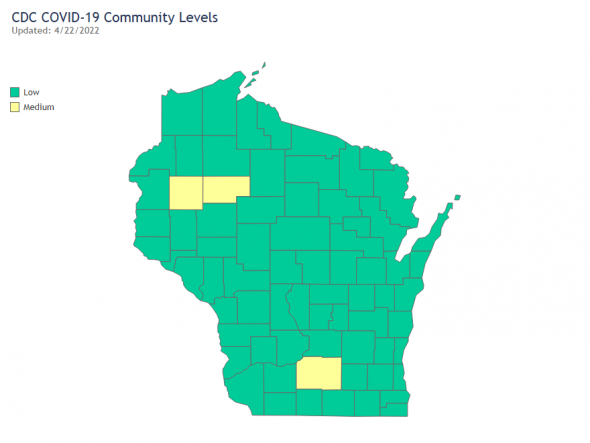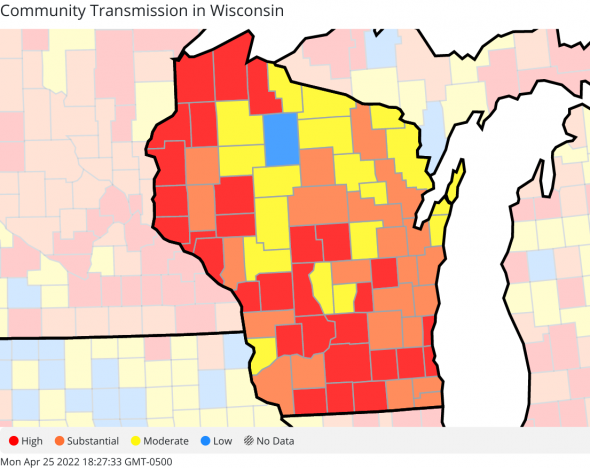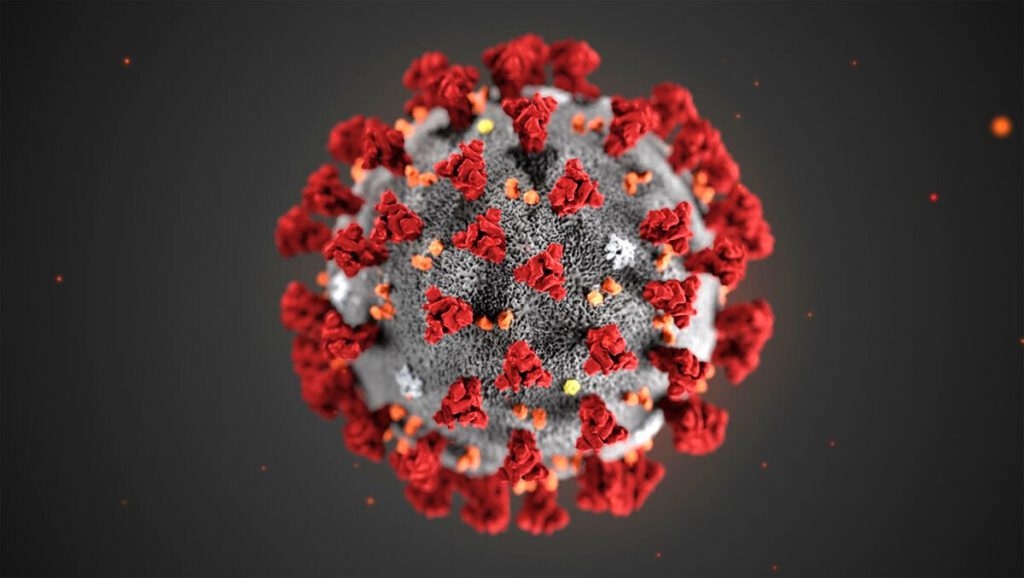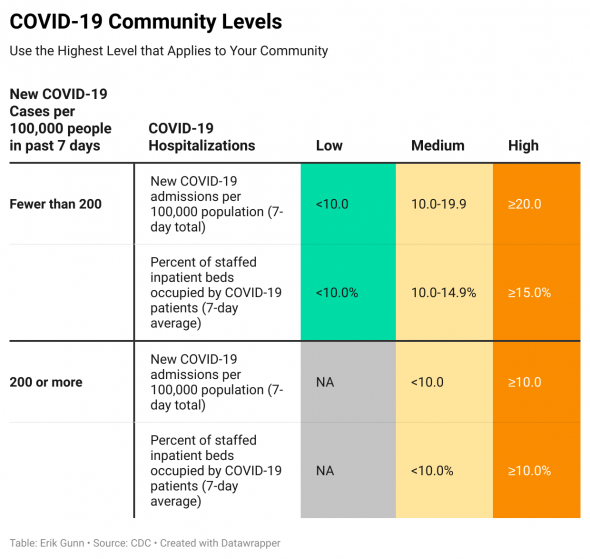State’s COVID-19 Cases Tripled in Last Month
Hospitalizations still low but numbers ‘concerning,’ and only 61% in state fully vaccinated.
A new COVID-19 surge is underway in Wisconsin, with the average number of new cases per day now three times what it was a month ago.
So far, however, hospitalizations have remained low in the aftermath of a massive spike at the beginning of 2022.
DHS reported that 8.2% of the COVID tests given each day over the past seven days were positive for the SARS-CoV-2 virus. That’s three times the seven-day average positive-test rate a month ago of 2.7%.
“These trends are concerning,” said Dr. Ben Weston, the chief health policy advisor for Milwaukee County and a professor at the Medical College of Wisconsin. “The overall disease burden is relatively low, but the positivity graph is going up.”
People considering whether to risk exposure to the virus by gathering in close quarters with others will need to consider both their tolerance for risk and what forms of protection they have, Weston said in an interview.
Risk factors include whether a person may have a compromised immune system, including from medications being taken for some other condition. Others include whether there are unvaccinated children, or older and more vulnerable adults such as a grandparent, sharing the same household, as well as the potential long-term effects of COVID-19.
Along with those and other risk factors are what Weston calls a person’s layers of protection, starting with the COVID-19 vaccine.
The current rate of people getting a vaccine for the first time is “dismally low” in Wisconsin, he said. According to DHS, 61% of Wisconsin residents have had the full initial series for a COVID-19 vaccine and 64% have had at least a first vaccine dose.
Children 5 to 11 years old are the youngest age group eligible for the COVID-19 vaccine, but so far, 27.5% in that age group have begun the process.
“It really is an uphill battle to make sure that parents are aware that children are eligible, and to make sure that they can go ahead and get their children vaccinated, both for COVID but as well as the immunizations that they may have missed in the past two years,” said Stephanie Schauer, DHS vaccine program manager, in a briefing Monday.
Weston said that in addition to reducing the risk of severe illness that could lead to a hospital stay, the vaccine protects against transmission.
In a gathering, “With folks you know who are all vaccinated, you can feel a lot safer,” he said, and gathering outdoors, where ventilation is open, also is likely to keep people safe from exposure.
He recommends masking, particularly when there isn’t universal vaccination or when a person is more vulnerable to the virus, to reduce the risk of exposure.
Hospitals have not yet felt a strain from the new uptick in cases. The Wisconsin Hospital Association reported that 185 people in the state were hospitalized for COVID-19 as of Monday, well below the most recent peak of more than 2,200 in January.
Earlier this year the federal Centers for Disease Control and Prevention (CDC) instituted a new way of assessing COVID-19 severity by “community level.” That new measurement combines reported infections from the virus with the numbers of people hospitalized for the illness.
So far, all but three counties in Wisconsin have maintained a “low community level” for COVID-19, even with the recent increase in infections, in part because hospitalization rates have stayed low.
A different measure, community transmission of the virus, remains high or substantial in more than half the state, however, according to the CDC. The agency maps community transmission rates separately from its community level rates. Community transmission is “high” in 30 counties and “substantial” in another 23 counties.

The CDC’s new “community levels” assessment combines case data and hospitalization data to classify a county’s “community level” for COVID-19. Click on the image to see it enlarged in a pop-out window. (CDC graphic via Wisconsin DHS)
Instead of that measure, however, the CDC uses its new community level system to benchmark guidelines for wearing masks and taking other precautions to reduce the risk of transmitting the virus.
The agency guidelines direct members of the public where the community level is “low” to focus on staying up to date with COVID-19 vaccines and boosters, ensure there is adequate indoor ventilation to refresh room air and reduce the airborne transmission of the virus, and to seek testing if symptoms develop.
Where community level is “medium,” the CDC suggests that people who may be vulnerable to the virus consider wearing a mask, and where it is “high,” the agency recommends that everyone mask.
In public health circles, the CDC’s revised approach has drawn some criticism for waiting until hospitalizations rise to raise concern, because hospitalization is a lagging indicator of the spread of the illness.
But Traci DeSalvo, director of the bureau of communicable diseases at the Wisconsin Department of Health Services (DHS), said in a recent media call that the community level measurement was valuable because it highlighted hospital cases.
“That’s a really important measure at this point in the pandemic, and with COVID-19, is really to make sure we have the capacity in our hospitals to care for the people who are most sick,” DeSalvo said in an April 14 Zoom presentation to reporters.

The CDC also keeps data showing community transmission levels of COVID-19. Click on the image to see it enlarged in a pop-out window.(CDC graphic via CDC website)
With Wisconsin still mostly at the low community level of disease, she said, “the most important thing” that DHS is recommending is COVID-19 vaccination — for the first time, if a person hasn’t yet started the vaccine, or with “any additional booster doses that you need to stay up to date.”
Weston said the new cases reflect the spread of the recently publicized newest form of the virus, called B.A.2, a sub-variant of omicron, which was responsible for the dramatic surge in cases in December and January. While the variant has been even more contagious than its predecessors, accounts from other countries where it has emerged have shown a variety of outcomes, from rapid spread to very little.
But the latest increase is a reminder that the virus remains persistent as it evolves.
“As much as all of us wish this weren’t the case, the pandemic isn’t over,” Weston said. “There are still going to be variants.”
COVID-19 cases rise again, tripling in the last month was originally published by the Wisconsin Examiner.
More about the Coronavirus Pandemic
- Governors Tony Evers, JB Pritzker, Tim Walz, and Gretchen Whitmer Issue a Joint Statement Concerning Reports that Donald Trump Gave Russian Dictator Putin American COVID-19 Supplies - Gov. Tony Evers - Oct 11th, 2024
- MHD Release: Milwaukee Health Department Launches COVID-19 Wastewater Testing Dashboard - City of Milwaukee Health Department - Jan 23rd, 2024
- Milwaukee County Announces New Policies Related to COVID-19 Pandemic - David Crowley - May 9th, 2023
- DHS Details End of Emergency COVID-19 Response - Wisconsin Department of Health Services - Apr 26th, 2023
- Milwaukee Health Department Announces Upcoming Changes to COVID-19 Services - City of Milwaukee Health Department - Mar 17th, 2023
- Fitzgerald Applauds Passage of COVID-19 Origin Act - U.S. Rep. Scott Fitzgerald - Mar 10th, 2023
- DHS Expands Free COVID-19 Testing Program - Wisconsin Department of Health Services - Feb 10th, 2023
- MKE County: COVID-19 Hospitalizations Rising - Graham Kilmer - Jan 16th, 2023
- Not Enough Getting Bivalent Booster Shots, State Health Officials Warn - Gaby Vinick - Dec 26th, 2022
- Nearly All Wisconsinites Age 6 Months and Older Now Eligible for Updated COVID-19 Vaccine - Wisconsin Department of Health Services - Dec 15th, 2022
Read more about Coronavirus Pandemic here






















